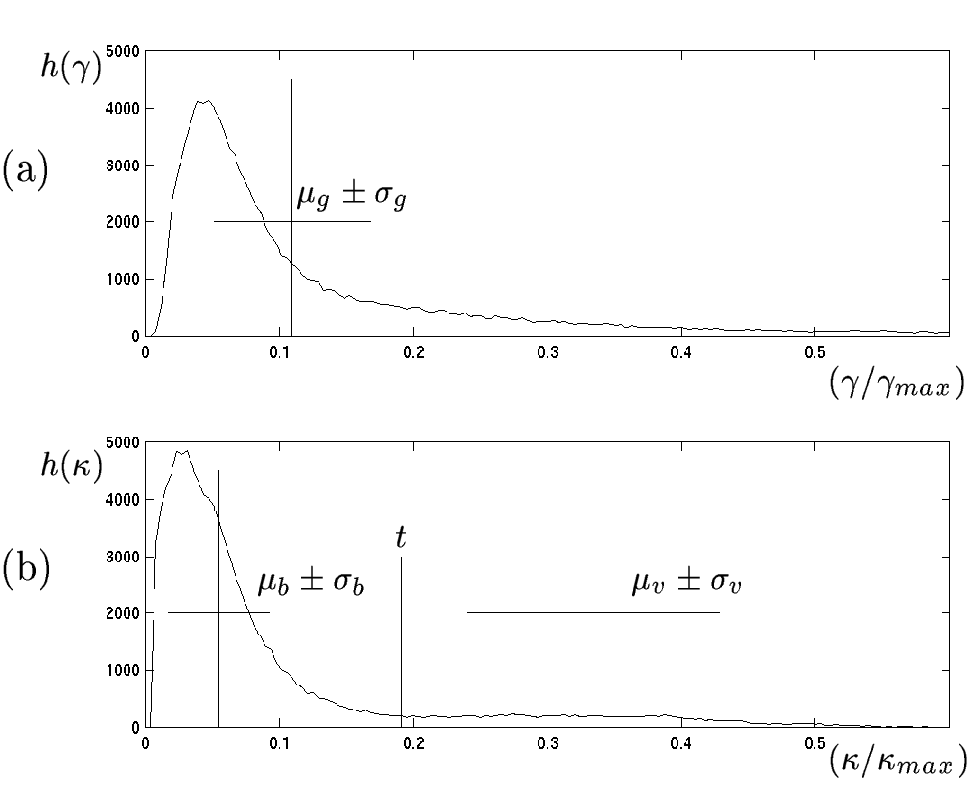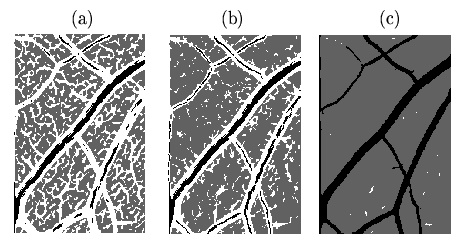The region growing algorithm we use is based on an iterative
relaxation technique.
The classification of pixels as vessel or background
is based primarily upon the maximum principal curvature
![]() , from which the criteria
for determining seeds are defined. Using spatial information from the classification of the
8-neighbouring pixels, classes grow initially in regions with low gradient
magnitude,
, from which the criteria
for determining seeds are defined. Using spatial information from the classification of the
8-neighbouring pixels, classes grow initially in regions with low gradient
magnitude, ![]() , allowing a relatively broad and fast classification while suppressing
classification in the edge regions where the gradients are large. In a second
stage the classification constraint is relaxed and classes grow based solely
upon
, allowing a relatively broad and fast classification while suppressing
classification in the edge regions where the gradients are large. In a second
stage the classification constraint is relaxed and classes grow based solely
upon ![]() to allow the definition of borders between regions.
to allow the definition of borders between regions.
 |
The histograms of both features ![]() and
and ![]() are calculated and
for
are calculated and
for ![]() only one class is used: low gradient, which
is defined as
only one class is used: low gradient, which
is defined as
![]() for the complete
histogram (Figure 8(a)), where
for the complete
histogram (Figure 8(a)), where ![]() is the mean and
is the mean and
![]() is the standard deviation.
is the standard deviation.
![]() is automatically divided into two classes using the
Otsu threshold
algorithm [22], and their means and standard deviations
are calculated: background, for
is automatically divided into two classes using the
Otsu threshold
algorithm [22], and their means and standard deviations
are calculated: background, for
![]() with mean
with mean ![]() and standard deviation
and standard deviation ![]() ; and
vessel, for
; and
vessel, for
![]() with mean
with mean
![]() and standard deviation
and standard deviation ![]() , where
, where ![]() is the
threshold (Figure 8(b)). The size of the interval for
each class varies depending on the value of a parameter
is the
threshold (Figure 8(b)). The size of the interval for
each class varies depending on the value of a parameter ![]() ,
which changes during the iteration process. Intervals
for each class are defined as:
,
which changes during the iteration process. Intervals
for each class are defined as:
![]() .
.
The algorithm begins by planting seeds for each region: background
seeds are pixels for which
![]() , whereas vessel
seeds are defined as
, whereas vessel
seeds are defined as
![]() . Figure 9(a)
shows an example of the planting stage where vessel seeds are shown
in black, background seeds in gray and unknown pixels in white.
. Figure 9(a)
shows an example of the planting stage where vessel seeds are shown
in black, background seeds in gray and unknown pixels in white.
 |
Region growing is an iterative process: An unlabelled pixel is classified as belonging
to class ![]() if it has at least one neighbour of class
if it has at least one neighbour of class ![]() already
classified and
if it fulfils a specific condition with initial
parameters
already
classified and
if it fulfils a specific condition with initial
parameters ![]() =1.
=1. ![]() will specify the size of the class interval
for the iteration
will specify the size of the class interval
for the iteration ![]() . Growing is repeated from left to right and
top to bottom until no more pixels are
classified. The constraints are relaxed by incrementing the
parameters
. Growing is repeated from left to right and
top to bottom until no more pixels are
classified. The constraints are relaxed by incrementing the
parameters ![]() in steps of 0.5 and the growing is repeated.
in steps of 0.5 and the growing is repeated.
In the first stage, the growing for both classes is restricted to regions with
low gradients allowing rapid growth of regions outside of the
boundaries, and allowing vessels to grow where the values of
![]() lie within a wide interval.
The condition for class vessel is:
lie within a wide interval.
The condition for class vessel is:
After alternating these two steps until no further classifications
are found, the final stage of the algorithm grows vessel and background
classes simultaneously without the gradient restriction. Now the
condition for class ![]() is:
is: